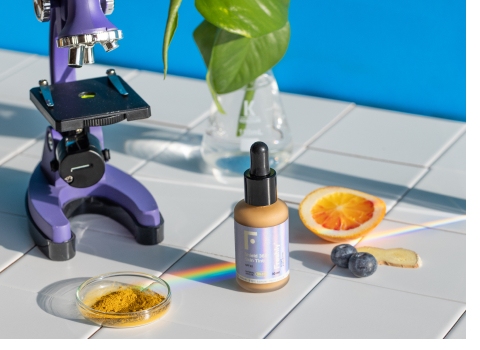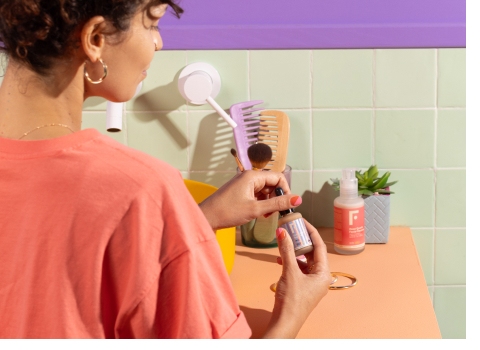Not sure what to look for? You can start from here:
Tinted Serum with SPF30 + Blue Light Protection: Does It Exist? Discover Skin Tint 360º.

Here are your essentials
for making it this far
If you are someone who...
-... aims to protect their skin from all types of daily radiation (not prolonged) and also desires a touch of color... keep reading.
-... always wonders whether to apply sunscreen before or after makeup... stay with us.
-... avoid makeup due to the "mask effect" and because they don't recognize themselves... this interests you.
-... look for makeup that provides hydration and powerful actives beyond color...
Get everything in 1 formula with Skin Tint.
What is a Skin Tint?
Not sure what a Skin Tint is? Spoiler alert! Once you know, you'll need to have it (we're warning you). In short, a Skin Tint is a multifunctional product for those looking to care for and protect their facial skin by simplifying their life and routine, without compromising on effective, healthy, and very natural results in 1 step (if possible). Are you that demanding? Then Skin Tint 360º has a lot to offer you. Why do we say this? Because every time we explain it, you’re captivated. Let’s put it to the test!
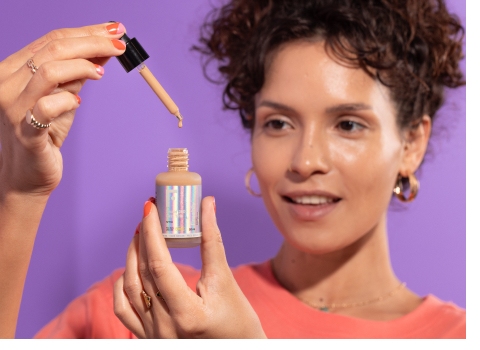
Benefits of a Skin Tint: What does Shield 360º Skin Tint offer my skin?
The Skin Tint developed by Freshly is a serum with SPF30 that adds a touch of color to the face, achieving a healthy-looking skin. Were you longing for something like this? Well, there’s more... Because we believe you can color your skin without makeup (shocked?). And we even believe you can color your skin and protect it from all daily radiation. This product is so comprehensive that we need a few more lines to properly explain it. Stay with us.
It’s not a foundation, nor just a serum. What is it, then? The multifunctional serum that makes your life easier. How? It enhances your skin tone, gives your face a juicy, hydrated, and even appearance, very natural, and as light as a feather, as if you were wearing nothing. And it also protects you from the sun's UV radiation (yes, in daily but not prolonged exposures, like on your way to work or out for a drink...). Could you ask for anything more? Yessss. The Shield 360º Skin Tint also protects you from blue light (HEV). What is it? What does that mean? We’ll tell you right now.
But hey... how does it achieve all this? Thanks to the combination of powerful actives such as triolein, cranberry seed oil, Haematococcus Pluvialis microalgae extract, and various types of iron oxides. We’ll detail this further below, you can't miss anything!
What is blue light?
Blue light is visible light emitted at wavelengths between 400 and 500 nm. What does all this mean? In simple terms, the main emitter of this type of light is the sun, but there are additional sources like the digital screens of mobile phones, computers, TVs, and LED lights, which we use in our daily lives and gradually generate more impacts of this type of light on our organism than the sun actually does.
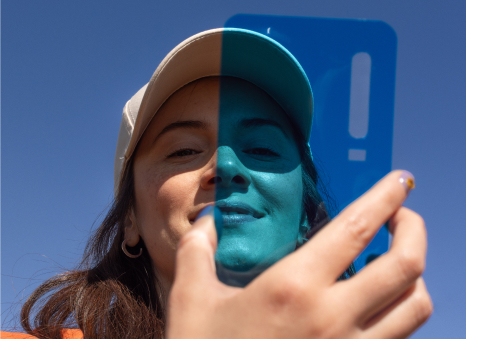
With the increasingly habitual use of these devices, studies have started to examine what these radiations mean for our skin. But before we delve into the effects of blue light on the skin, let's review the types of ultraviolet radiation (from the sun) we are exposed to every day:
- UVA rays reach the epidermis, the outermost layer of the skin, but also the dermis, which is beneath the first and is thicker. The greatest risk from these solar radiations comes from the cumulative effect of sun exposure, meaning, over the years, they can cause wrinkles, spots, and other skin conditions.
- UVB rays affect the epidermis, the most superficial layer of our skin. These rays are what cause burns, redness, and inflammation.
To protect against these types of radiations, there are sunscreens (SPF) that can be formulated with physical or chemical filters. If you want to know more about sunscreens, we tell you everything in this article. But the question now is, how can we protect ourselves from blue light? We'll tell you right away.
Effects of blue light on the skin
Numerous studies have been conducted, but there is still much to investigate in this regard. What we want is to share knowledge so you can draw your own conclusions.
*Summaries collected in the study Blue Light in Dermatology. Sadowska, M.; Narbutt, J., and Lesiak A. Blue Light in Dermatology. Life 2021, 11 (7), 670
It has been shown that blue light generates reactive oxygen species (ROS) and induces oxidative damage to the skin, similar to UV radiation. Moreover, it penetrates deeper into the skin layers, inducing cellular dysfunction.
According to Dong et al., blue light decreases the transcription of the PER1 gene in keratinocytes. What does this mean? This is a clock gene, involved in the circadian rhythm. What is happening is that, due to prolonged exposure to these types of mobile devices (at any hour), cells might be experiencing daylight when it is actually nighttime. This generates the hypothesis that blue light interferes with the skin cells' nocturnal rhythm, compromising skin cell regeneration and repair.
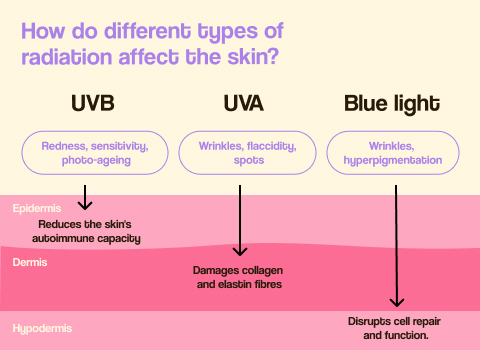
In summary, according to José Aguilera, a PhD in biology and academic at the Spanish Academy of Dermatology and Venereology (ADV). “Potentially, blue light can cause skin damage due to oxidative stress. This will activate melanocytes to increase cutaneous melanin. It has also been seen to affect the skin's water state and the cutaneous barrier because exposure to this radiation alters the synthesis of some proteins. All this can result in increased aging and greater pigmentation.”
Our habits have something to do with it...
Nowadays, we are no longer exposed to adequate levels of natural light throughout the day, yet, we are overexposed to high levels of artificial light (workdays in offices, in front of a computer, hours of use of mobile phones and tablets...)
Therefore, while further research is conducted on the impact of blue light, it would be interesting to adopt measures to mitigate or reduce its impact on the skin after prolonged exposures, don't you think?
How to protect my skin from blue light?
Natural cosmetics have already taken some steps in this direction and have developed actives to reduce the impact of blue light on the skin. Specifically, in the Shield 360º Skin Tint, we have:
- Blue Light Protection Active. This active combines triolein with cranberry seed oil and the extract of the microalgae Haematococcus Pluvialis. This powerful combination has the ability to strengthen the skin's natural antioxidant defense against excessive exposure to UV radiation and blue light. Additionally, it stimulates the antioxidant system to help rebalance the circadian rhythm and strengthen the synchronization of the biological clock.
- Pigments Barrier Blend. This is a mix of various iron oxides: yellow, red, and black, which, in combination with Zinc oxide, provides protection across the entire spectrum of blue light. It’s important to note that these iron oxides are completely safe and effectively protect in a sustainable manner.
And we still have to talk about one more benefit of this product, and it's the fact that it adds such a healthy, juicy, and natural touch of color to our skin that makes it irresistible. You might be thinking that it is then a BB Cream or a CC Cream, well, we're sorry to say that it's not.
What a Skin Tint Is Not?
It’s not a foundation, not just a serum, not a BB Cream, not a CC Cream... How do they differ?
What is a BB Cream? What is a CC Cream?
The main function of a BB Cream and CC Cream is to combine skin care, tone unification, and, in most cases, sun protection. Normally, they are conceived as makeup products. Since their coverage is more significant than that of tinted sunscreens but lighter than traditional makeup foundations. And, as mentioned, they usually have SPF 15, 30, or 50. We could say they are halfway between a tinted sunscreen and a makeup foundation.
Differences between a BB Cream and a CC Cream, with a Skin Tint
Unlike BB Creams and CC Creams, the main function of a Skin Tint is to care for the skin with antioxidant and hydrating actives, providing a subtle color with a natural finish and UV radiation protection (SPF), and in the case of Shield 360º Skin Tint, it also includes blue light protection (screens). Therefore, it's ideal for daily use, protecting your skin both outdoors and indoors. But beware! If we plan to sunbathe, we should always apply sunscreen, as a Skin Tint is not meant for direct and prolonged sun exposure.
Precisely because of all these properties, we identify it as a tinted serum, with light coverage so that the skin naturally radiates. And that's also why it doesn't cover freckles, marks, or pimples (nor is it what we aim for).
The Multifunctional Serum That Makes Your Life Easier...
It’s super easy to apply, its finish is so light that you can put it on even without looking in the mirror.
It simplifies 3 steps of your daily routine into a single step, saving you time. You’ll still look good, and your skin will feel better because it will be protected from all daily radiations thanks to its 99.6% natural formula, which leaves no greasy sensation nor cracks—it's like a breath of fresh air instantly!
And is there only one shade? We knew you'd ask that question, so we've developed 3 shades for you to choose the one that best suits your skin. Below you can see them applied. Which one do you choose?
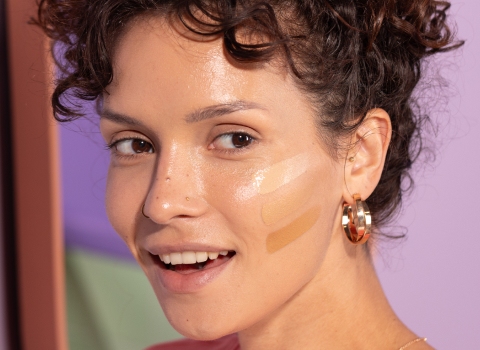
**Sources:
- Dong, K.; Goyarts, E.C.; Pelle, E.; Trivero, J.; Pernodet, N. Blue Light Disrupts the Circadian Rhythm and Create Damage in Skin Cells. Int. J. Cosmet. Sci. 2019, 41, 558–562.
- Yoo, J.A.; Yu, E.; Park, S.-H.; Oh, S.W.; Kwon, K.; Park, S.J.; Kim, H.; Yang, S.; Park, J.Y.; Cho, J.Y.; et al. Blue Light Irradiation Induces Human Keratinocyte Cell Damage via Transient Receptor Potential Vanilloid 1 (TRPV1) Regulation. Oxidative Med. Cell. Longev. 2020, 2020, 1–14.
- Nakashima, Y.; Ohta, S.; Wolf, A.M. Blue Light-Induced Oxidative Stress in Live Skin. Free Radic. Biol. Med. 2017, 108, 300–310.
- Austin, E; Huang, A.; Adar, T; Wang, E y Jagdeo, J. Electronic device generated light increases reactive oxygen species in human fibroblasts. 2018. Lasers in Surgery and Medicine. Volume 50, Issue 6; Pages 689-695. — Leyenda EDGL (Electronic Device Generated Light)
- Rascalou, A.; Lamartine, J.; Poydenot, P.; Demarne, F; Bechetoille, N. Mitochondrial damage and cytoskeleton reorganization in human dermal fibroblasts exposed to artificial visible light similar to screen-emitted light. 2018. Journal of Dermatological Science. Volume 91, Issue 2, P. 195-205
- Chamayou-Robert, C; DiGiorgio, C.; Brack, O.; Doucet, O. Blue light induces DNA damage in normal human skin keratinocytes. Photodermatology, Photoimmunology & Photomedicine. 2022. Volume 38. Issue 1. P. 1-91
Freshly wants to tell you something! At Freshly we keep on learning every day how to make decisions that bring us closer to a better future. Sometimes we are called dreamers, but what we really have is an optimistic vision and clear path for reaching that tomorrow.
Would you like to join this adventure? If you're here, it's because you are a demanding person when it comes to taking care of your body and the planet. By subscribing to the newsletteryou will receive articles like this one to continue learning, as well as news and exclusive discounts. Are you up for it?




